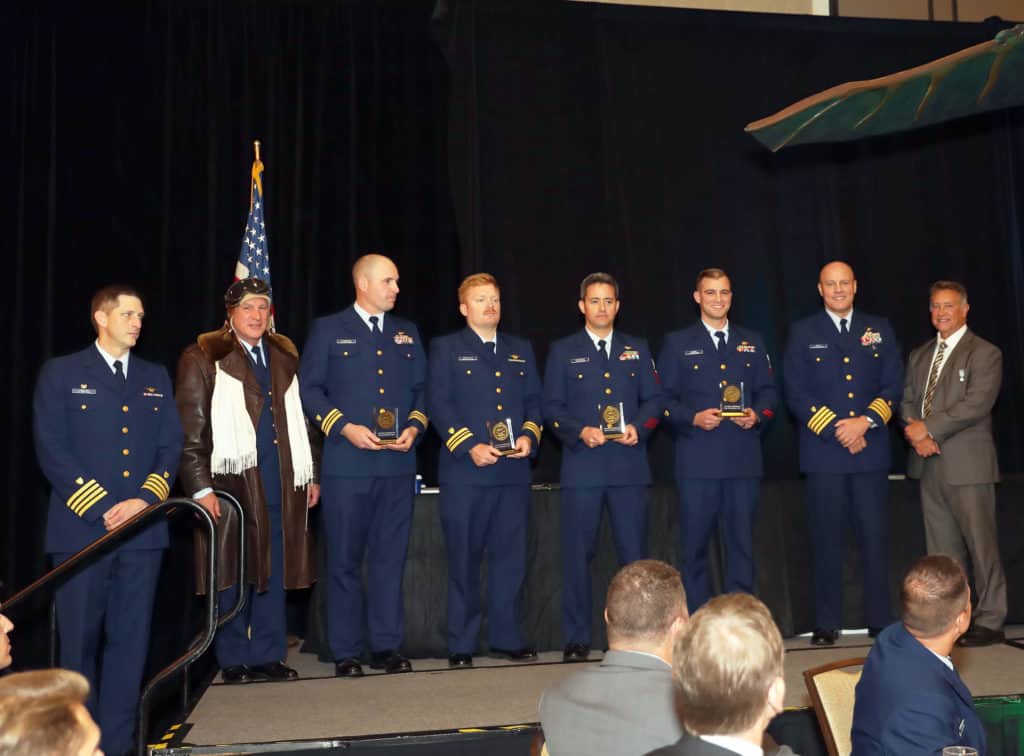In recognition of their heroic efforts on October 19, 2021, when CG-6037 responded to the alert of the fishing vessel PATRICIA LEE.
For heroic achievement while serving as aircrew aboard CG-6037 on October 19, 2021. At 1900L, the crew departed from the forward operating location Cold Bay, Alaska, to MEDEVAC a critically injured crewmember aboard F/V Patricia Lee, 60 NM East of Adak, Alaska. This was a high risk due to severe turbulence, icing, high seas, and IFR conditions. CG6037 proceeded through areas of extreme turbulence and low visibility conditions to refuel in Dutch Harbor, Alaska. Downdrafts shot plumes of water 100-200 feet into the air. CG-6037 departed Dutch Harbor at 2230L. The wind gusted to 62 knots and snow squalls limited visibility. After a two-hour transit, CG-6037 found the vessel violently pitching and rolling in 25-foot seas. With the hoisting area located between two 70-foot masts, they proceeded with a dry run overhead check to evaluate the feasibility of a hoist. The pilot flying quickly went lost target, and with the masts moving unpredictably in the confused seas, elected to fly away. A second dry-run resulted in near lost-target conditions, and the crew elected to back away to formulate a plan. Despite steady 45-knot winds, the crew put the aircraft 30 degrees out of the wind line and moved in for a third try. The flight mechanic began to lower the rescue swimmer using the hoist. Waves crashing over the ship’s deck caused the weight bags to become fouled in a scupper drain. The Rescue Swimmer readied his survival knife to cut the trail line if an abort was needed. The swimmer made it to the ship safely. Next, the litter was delivered. After the litter was safely delivered, the swimmer passed word that weight bags were lost and proceeded to ready the patient. Demonstrating superb ingenuity, the flight mechanic identified a water bottle to use as a weight bag. During the recovery of the litter, an abnormally large swell struck the stern of the vessel.
Quick conning commands and control inputs prevented the litter from striking the pilothouse as the mast surged forward toward the helicopter but only narrowly. With highly trained crew coordination the flight mechanic and the pilot kept position and controlled the litter to bring the patient into the cabin. Misfortune struck at the worst time – the flight mechanic’s intercommunications cord became entangled in the litter and disconnected. The pilot monitoring quickly recognized the situation and proceeded to provide conning commands to maintain position using video from the hoist camera. He also directed a civilian camera crewman on the mission to assist the flight mechanic. After a full minute of maintaining position over the vessel, the flight mechanic was able to reestablish ICS communications and recover the swimmer. The crew departed the vessel with one minute of fuel to bingo and safely navigated severe turbulence to deliver the patient to EMS in Dutch Harbor. The crew of CG-6037 demonstrated exceptional bravery, determination, and ingenuity during a rescue that reached a national audience. Their actions are in keeping with the highest traditions of the Coast Guard Aviation Association and the United States Coast Guard.
